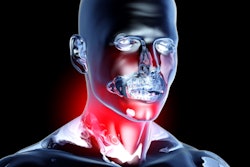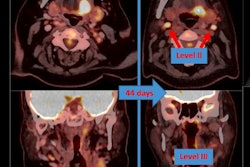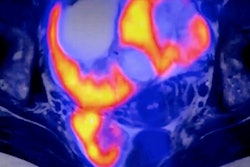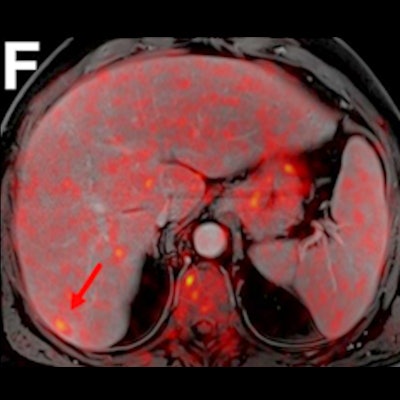
PET/MRI helps clinicians stage cancer treatment as well as PET/CT -- and finds more than 25% additional cancers, according to a study published in the Journal of Nuclear Medicine. It also reduces overall radiation exposure.
"Due to the higher soft-tissue contrast, PET/MRI improves lesion detection and reduces the need for additional examinations in comparison to PET/CT," said study co-author Dr. Benedikt Schaarschmidt of University Hospital Essen in Essen, Germany, in a statement released by the Society of Nuclear Medicine and Molecular Imaging (SNMMI). "Especially in younger patients who need repeated diagnostic procedures, our data advocate the use of PET/MRI due to the markedly reduced radiation exposure of PET/MRI when compared to PET/CT."
PET/CT tends to be the gold standard for oncologic imaging because of its sensitivity, even though PET/MRI has higher soft-tissue contrast and lower radiation exposure, the group noted. But there are few data on PET/MRI's performance for oncologic imaging.
To address the knowledge gap, Schaarschmidt's team conducted a study that included 918 patients who underwent 1,003 PET/MRI exams; the patients also had PET/CT imaging. Indications included lung cancer, gastrointestinal cancer or neuroendocrine cancer, gynecologic or breast cancer, prostate cancer, lymphoma, melanoma, head and neck cancer, and malignant bone disease (J Nucl Med, August 1, 2020, Vol: 61:8, pp. 1131-1136).
Nuclear medicine radiologists compared the exams, looking for additional findings on PET/MRI and probable diagnoses, additional but unclear findings on PET/MRI that required follow-up, and classification of indeterminate findings on PET/CT by PET/MRI. The study authors compared the radiation doses for each of the modalities.
Schaarschmidt and colleagues discovered the following:
- PET/MRI identified additional, pertinent clinical findings in 26.3% of the exams compared with PET/CT.
- Of these additional PET/MRI findings, 5.3% were malignant, which led to a change in cancer staging in 2.9%.
- PET/MRI clarified indeterminate PET/CT findings in 11.1% of exams.
- Estimated mean effective dose for PET/CT was 17.6 mSv, compared with 3.6 mSv for PET/MRI, a reduction of 79.6%.
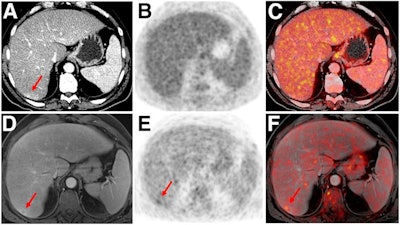 Indeterminate lesion on PET/CT classified by PET/MRI for 53-year-old man with lung cancer. Contrast-enhanced CT (A), PET (B), and fused F-18 FDG PET/CT (C) images are displayed in comparison with contrast-enhanced T1-weighted MRI (D), PET, and fused F-18 FDG PET/MRI (F) images. In CT (A), hyperdense, subcentimeter liver lesion (arrows) in segment VII is suggestive of transient hepatic attenuation difference or small hemangioma. As malignancy cannot be excluded, it needs further investigation. On PET/MRI, lesion is clearly classified as metastasis because of contrast enhancement and tracer uptake due to later acquisition time point. Follow-up CT confirmed diagnosis after 78 days. Image courtesy of SNMMI.
Indeterminate lesion on PET/CT classified by PET/MRI for 53-year-old man with lung cancer. Contrast-enhanced CT (A), PET (B), and fused F-18 FDG PET/CT (C) images are displayed in comparison with contrast-enhanced T1-weighted MRI (D), PET, and fused F-18 FDG PET/MRI (F) images. In CT (A), hyperdense, subcentimeter liver lesion (arrows) in segment VII is suggestive of transient hepatic attenuation difference or small hemangioma. As malignancy cannot be excluded, it needs further investigation. On PET/MRI, lesion is clearly classified as metastasis because of contrast enhancement and tracer uptake due to later acquisition time point. Follow-up CT confirmed diagnosis after 78 days. Image courtesy of SNMMI.The study suggests that PET/MRI could be an effective alternative to PET/CT for tracking and treating cancer patients, according to the authors.
"Hybrid imaging examinations are now part of complex diagnostic algorithms in multiple cancer types," Schaarschmidt said in the statement. "Based on our data, PET/MRI could be an important adjunct to PET/CT by providing diagnostic advantages and improving diagnostic algorithms in numerous cancers at the same time. Furthermore, the markedly reduced radiation exposure of PET/MRI could lead to a more frequent use of this examination in oncological patients, most notably for treatment monitoring."






